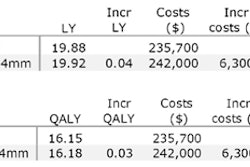Face it, folks: In less than six months, all healthcare providers who bill for the technical component of advanced imaging services must be accredited under the Medicare Improvements for Patients and Providers Act (MIPPA) of 2008. More than a few facilities are scrambling to get in under the wire.
Even worse, there's a growing sense that MIPPA's implementation in January 2012 could have an unintended negative impact on facilities' ability to provide imaging services -- despite its noble goal of curbing overutilization among providers of low-quality scans. Some industry watchers even believe it could lead to further increases in the cost of imaging and less access as some nonhospital-based imaging providers simply close shop.
Attacking overutilization
When it was passed in July 2008, the centerpiece of MIPPA was an 18-month postponement of the sustainable growth rate (SGR) formula, which at the time was scheduled to rise 10.6%. But the legislation also included requirements designed to address perceived overutilization of advanced diagnostic imaging services, primarily by requiring providers of these services to be accredited by January 2012 to receive Medicare reimbursement for the technical component of scans.
So why the problem? Because there's no grace period built into the law -- and that means the beginning of the end of nonhospital-based advanced imaging, according to AuntMinnie.com Forum poster Joe Palmisano, a partner at Physicians Imaging Solutions, which works with physician groups and clinics.
"There is no provision in this law for a grace period for new imaging facilities and for existing facilities who want to swap out equipment," Palmisano wrote in his post. "This omission allows [the U.S. Centers for Medicare and Medicaid Services (CMS)] to make it virtually impossible to open any new independent imaging facilities after January 1, 2012. It will also cause any existing facilities to basically close down if they need or desire to upgrade or swap out equipment."
After January 1, a new supplier will not receive reimbursement until it becomes fully accredited. And if a facility has only one device, stops imaging on it, and withdraws it from accreditation to bring a new unit online, is the facility still accredited? The answer is no, Palmisano said.
"There's a gap in the accreditation because in this scenario, there's no unit onsite that has passed accreditation requirements," he wrote. "It's the same as if the supplier was starting the accreditation process after January 1."
New imaging facilities that begin business after the deadline will have to operate without being reimbursed until they are accredited.
"A facility would need to remain open and operational for at least six months before it can be accredited and reimbursed," Palmisano wrote. "Some may say that this is only Medicare, but we all know from experience that private payors follow Medicare rather quickly, and who has deep enough pockets to operate an imaging facility for free for six months?"
What's more, the accreditation process is widely seen as time-consuming. Indeed, if you're just starting to investigate accreditation now, you could be in trouble, according to W. Kenneth Davis Jr., an attorney at the law firm Katten Muchin Rosenman.
"This accreditation process is almost certainly more demanding than any other physician groups or independent facilities have gone through," Davis said. "I've been telling people for months now, 'Don't wait until six months to a year before, you're going to run out of time.' No matter which organization does the accreditation, the process takes several months. You're going to have a bit of a problem if you get to January 1 and the process isn't complete."
Market squeeze
A further consequence? There will likely be market squeeze, according to Davis.
"We'll see capacity within the market constrict as people put up their hands and say, 'It's not worth it [to get accredited],' " he said. "There's no question that's going to happen, particularly because this accreditation is a more intensive process that imposes additional operational costs. Clearly, it's going to drive up the cost of imaging. One wonders if the lawmakers fully thought the consequences through when they passed the legislation."
If a practice that currently bills Medicare for services other than the technical component of advanced diagnostic imaging services is currently unaccredited, but is scheduled to acquire an imaging machine at some point in 2012, it will not be able to complete the accreditation process ahead of time because the accreditation requires that the supplier currently possess the machine. But because MIPPA does not authorize any grace period or retroactive payments, suppliers won't be able to bill Medicare for the technical component of those services.
"Demanding that all facilities be accredited is a good thing," Palmisano wrote. "But not providing a grace period in which facilities can become accredited is essentially legalizing an end to medical imaging outside of the hospitals. Without grace period language, MIPPA will end easy access to care, eliminate thousands of jobs, and push the cost of healthcare even higher."
It's up to CMS to provide a corrective fix, according to Tom Greeson, a partner at Reed Smith who specializes in radiology-related regulatory matters.
"For facilities that are brand new, and have a new modality like MR or PET coming in, they may spend enormous amounts on a capital investment that will lie fallow, without bringing in any cash flow, until the facility is accredited," Greeson said. "It's a chicken-and-egg thing. Some payors won't contract with you until you're enrolled with Medicare, but according to the law as it stands, you can't enroll with Medicare until you're accredited. CMS needs to provide a corrective fix."
If part of the impetus for MIPPA is to bump lower quality imaging suppliers out of the market -- who may or may not be self-referring physicians -- the effect may be too efficient, Davis said.
"It's hard to fully gauge the impact on supply," he said. "We may end up seeing a reduction in services in some areas, and if the supply goes down and demand stays the same, prices will increase. One of the unintended consequences of MIPPA could be the magnitude of this supply shift."




















